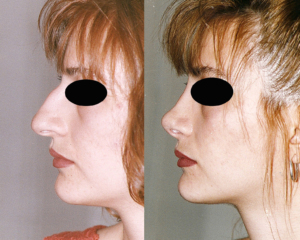Rhinoplasty

The nose is the central element of the face. Any possible malformation such as deviation, hump, large size, is often unpleasant affects the general appearance of the face. Furthermore, external malformations are often combined with internal abnormalities, such as septal deviation and/or turbinate hypertrophy, causing significant functional problems.
Rhinoplasty aims at correcting both aesthetic and functional problems of the nose, this is why it is often called Functional Rhinoplasty. If planned carefully, it has immediate and impressive results and can significantly improve the patient’s quality of life.

Structure of the Nose
The nasal bones are under the upper part of the external nose, which feels hard on palpation. The lower, softer part, is composed by the lateral cartilages, as shown in the picture. All this structure is supported from below by a thin but firm wall, the nasal septum, made of cartilage and bone. Nasal deformities are due to either abnormal growth or traumatic lesions of these bony and cartilaginous structures.
Planning of Operation
The ideal Rhinoplasty must correct all deformities of the internal and external nose, giving an aesthetically pleasant result, which does not attract attention. For the operation planning the surgeon will take into consideration the patient’s gender, age, shape of the face, quality of skin, but also the overall appearance: A small, thin, upward tipping nose will not fit well on the face of a tall woman, or a man with rough, square profile. Especially in men, rhinoplasty is aimed more strictly at an accurate correction of the problem, without exaggerations.
According to your gender, age, face shape and the rest of your characteristics, the surgeon will suggest the type of intervention which is most suitable for you.
In every case, the planning of the operation comes after a thorough discussion between the doctor and the patient. We must understand what exactly you do not like on your nose, and you must realise what we can really do about it. Communication and trust between the patient and the surgeon are of upmost importance for a good result, but mainly for your satisfaction of it.
It is nice to see how much difference a slight improvent of the nose makes to the face.
The Operation
The operation is done under general anaesthesia and lasts for about an hour, or longer, if it is combined with turbinate reduction and/or septoplasty. Incisions are made inside the nostrils, so there are no visible scars postoperatively. We use absorbable sutures, which do not need to be removed. Inside the nostrils we place a thin gauze for twenty four hours, and the nose is stabilized with a plaster splint for ten days.

The Day After
Although many patients find it difficult to believe, there is no pain after this operation. There may be some swelling and bruising of the eyelids, which typically subsides in 2 to 4 days. When the plaster splint is removed, the result is immediately evident, although a remaining light swelling may need several months to resolve completely. This is why the final result is judged after at least twelve months.
We usually recommend a two-week sick leave after this operation. To avoid possible bleeding, physical stress is to be avoided for three weeks. The skin of the nose will be sensitive during the first postoperative year. Careful daily toilet of the nose with liquid soap and moisturizing cream is important. Sunscreen with high protection must be applied before exposure to the sun. Sunglasses or spectacles are to be avoided during the first two months.
This website aims at providing simplified scientific information and not medical advice on specific conditions or individual cases. In this respect, it cannot replace the consultation and documented opinion of a specialist physician.